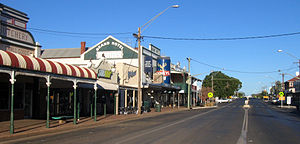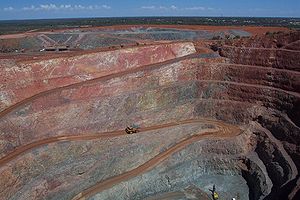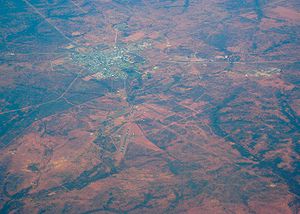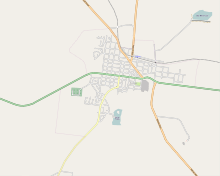- Cobar, New South Wales
-
Cobar
New South Wales
Location of Cobar in New South Wales (red)Population: 5,194[1] Established: 1870 Postcode: 2835 Elevation: 260 m (853 ft) Location: - 711 km (442 mi) from Sydney
- 457 km (284 mi) from Broken Hill
LGA: Cobar Shire State District: Barwon Federal Division: Parkes Mean max temp Mean min temp Annual rainfall 25.1 °C
77 °F12.7 °C
55 °F406.5 mm
16 inCobar is a town in central western New South Wales, Australia. It is located 712 km (442 mi) northwest of Sydney. It is at the crossroads of the Kidman Way (to Queensland) and Barrier Highway (to South Australia). The town and the Local Government Area, the Cobar Shire, are on the eastern edge of the outback. At the 2006 census, Cobar had a population of 5,194,[1] out of Cobar Shire's population of about 7,000. The Shire has a surface of 44,065 km2, about two thirds the size of Tasmania.[2]
Contents
History
The name Cobar is derived from the Aboriginal Ngiyampaa word Kuparr, Gubarr or Cuburra, meaning 'red earth' or 'burnt earth', the ochre used in making body paint for Corroborees.[3] [4] It has also been suggested, but it is less likely, that the name may represent an Aboriginal attempt to pronounce the word 'copper'.[5]
Some of the most significant Aboriginal rock art in NSW is within the shire. The indigenous Ngiyampaa/Wangaapuwan traditions of this diverse bio-region are best represented in the rock art of Mount Grenfell, 40 km west of Cobar. Over 1,300 depictions of humans, hand stencils and animals are at this site.
Pastoralists began to settle the area in the mid-1860s. Copper was discovered in 1870, leading to settlements being founded with Australia's European and Asian gold rush immigrant arrivals. The Great Cobar Copper Mining Company Limited was established in 1878. It and subsequent companies operated a number of light railways[6] carrying ore and similar material, as well as timber for mine supports. Cobar and many mining outskirts accommodated the miners who travelled to the area in the late 1880s. At this time Cobar was very much a Cornish town.[7] Several fine heritage buildings from the late 1880s/early 1900s settlement are still in existence, including the Great Western Hotel (1898), reputed to have the longest iron lace verandah in the Southern Hemisphere, the Cobar Court House (1887) and Court House Hotel (1895) in Barton Street, as well as the interesting Cobar Heritage and Visitor Information Centre, located in the beautiful former Mines Office (1910). On Hillston Road southeast out of town is Fort Bourke Hill which affords an excellent view of the town, and Towser's Huts, a series of stone miners' cottages dating possibly from as early as the 1870s.
At its peak, Cobar had a population on 10,000 and its own stock exchange. However, copper mining operations ceased in 1920, and by the 1930s the town's population had dropped to little over 1,000, only to rise again and stabilise at around 3,500 through the 1970s and early 1980s. In the 1980s, Gold, silver, lead and zinc were discovered in the area, which led to a further population increase. The town's current positive economic development is due to the affluence of the mining boom. Three important mining belts are operational in the Cobar area: The Cobar belt, the Canbelego belt and the Girilambone belt. Visits to mine sites may be arranged through the Cobar Heritage and Visitor Information Centre overlooking the open cut mine. The Festival of the Miners' Ghost, held during the last weekend in October, is a festival celebrating the spirits of the old miners.
Economy
The Cobar economy relies heavily on trade with the local mines and their employees, and consequently, on world metal prices. During 2008, after a fall of 75% in world zinc prices, one local mine cut 540 of 655 jobs, with flow on effects felt by many other businesses. Over the year Cobar's workforce reduced by 10%.[8] The town has increasing benefit from tourists passing through due to its location at the intersection of the Kidman and Barrier Highways. It also benefits from being the seat of the local government area. Cobar has two primary schools, a high school and a 31-bed hospital for acute care.
Map of Cobar
OpenStreetMap of Cobar [1]
Climate
Cobar has a semi-arid climate (Köppen climate classification BSh) with hot summers and cool winters. It has a median annual rainfall of 390mm. Rainfall is extremely variable, particularly in late summer and early spring. The highest rain falls have been in excess of 200mm in any one month. Rainfall is generally only about 4 days per month.
Average monthly maximum temperatures range from 13C to 20C in winter and 37C to 45C in summer. Average monthly minimum temperatures range from 2C to 8C in winter to 14C to 24C in summer.
The average relative humidity in Cobar during the summer is about 30% in the afternoon and about 50% at 9am. In winter it is about 45% at 3pm, and about 75% at 9am.
Annual mean wind speed at 9am and 3 pm is about 12.2 km/h with lesser speeds on winter mornings.
Climate data for Cobar Month Jan Feb Mar Apr May Jun Jul Aug Sep Oct Nov Dec Year Record high °C (°F) 47.0
(116.6)46.1
(115.0)41.5
(106.7)36.0
(96.8)29.6
(85.3)26.3
(79.3)25.7
(78.3)30.5
(86.9)38.0
(100.4)39.4
(102.9)43.6
(110.5)44.1
(111.4)47.0
(116.6)Average high °C (°F) 34.0
(93.2)33.3
(91.9)30.1
(86.2)25.2
(77.4)20.0
(68.0)16.5
(61.7)15.8
(60.4)18.0
(64.4)21.9
(71.4)26.0
(78.8)29.4
(84.9)32.6
(90.7)25.2 Average low °C (°F) 20.5
(68.9)20.1
(68.2)17.1
(62.8)12.9
(55.2)9.0
(48.2)6.2
(43.2)5.0
(41.0)6.2
(43.2)9.1
(48.4)12.6
(54.7)15.8
(60.4)18.7
(65.7)12.8 Record low °C (°F) 10.3
(50.5)8.4
(47.1)6.2
(43.2)3.2
(37.8)0.4
(32.7)−2
(28.4)−2.3
(27.9)−2.5
(27.5)−0.3
(31.5)2.9
(37.2)4.4
(39.9)9.1
(48.4)−2.5
(27.5)Precipitation mm (inches) 47.6
(1.874)42.8
(1.685)34.4
(1.354)26.7
(1.051)33.0
(1.299)27.6
(1.087)28.1
(1.106)27.4
(1.079)24.5
(0.965)35.2
(1.386)34.3
(1.35)36.2
(1.425)397.3
(15.642)Source: [11] Notable people
- Nik Kosef, former rugby league player for the Manly-Warringah Sea Eagles, 1996 premiership player, NSW & Australia representative
- Ernie Toshack, cricketer, member of Bradman's Invincibles
- Jemma Heather, state representative 4 times.
See also
References
- ^ a b Australian Bureau of Statistics (25 October 2007). "Cobar (Urban Centre/Locality)". 2006 Census QuickStats. http://www.censusdata.abs.gov.au/ABSNavigation/prenav/LocationSearch?collection=Census&period=2006&areacode=LGA11750&producttype=QuickStats&breadcrumb=PL&action=401. Retrieved 2007-10-28.
- ^ http://www.cobar.nsw.gov.au/ Retrieved 07-01-2010
- ^ Donaldson, Tamsin. "Ngiyampaa". Macquarie Aboriginal Words. Sydney: Macquarie Library. p. 38.
- ^ Reed, A.W. Aboriginal Place Names. Sydney 1967: Reed New Holland. p. 26.
- ^ "Cobar". Geographical Names Board of New South Wales. http://www.gnb.nsw.gov.au/name_search/extract?id=KWqwjzWAKW. Retrieved 28 June 2009.
- ^ Shoebridge, J.W. The Railways of The Great Cobar, Australian Railway Historical Society Bulletin, September, 1969 pp. 189-218
- ^ http://books.google.co.uk/books?id=wgoFxfSTfYAC&pg=PA227&lpg=PA227&dq=australia+first+fleet+cornwall&source=bl&ots=pQ8ZsDZmGb&sig=TfiFNvZO2PtZBgpAQUgjeTEuoqw&hl=en&ei=-YAHTYaRHsKYhQfXyLnuBw&sa=X&oi=book_result&ct=result&resnum=1&sqi=2&ved=0CBoQ6AEwAA#v=onepage&q=australia%20first%20fleet%20cornwall&f=false
- ^ http://www.smh.com.au/text/articles/2009/01/23/1232471590783.html From boom town to bust Retrieved 24-01-2009
- ^ http://www.bom.gov.au/weather/nsw/cobar/climate.shtml Climate of Cobar, Retrieved 24-01-2009
- ^ http://en.wikipedia.org/w/index.php?title=Cobar,_New_South_Wales&action=submit Retrieved 2009-01-24
- ^ "BOM - Cobar weather statistics". http://www.bom.gov.au/climate/averages/tables/cw_048027_All.shtml=.
External links
Categories:- Towns in New South Wales
- Mining towns in New South Wales
- Australian Aboriginal placenames
- Populated places established in 1870
Wikimedia Foundation. 2010.





